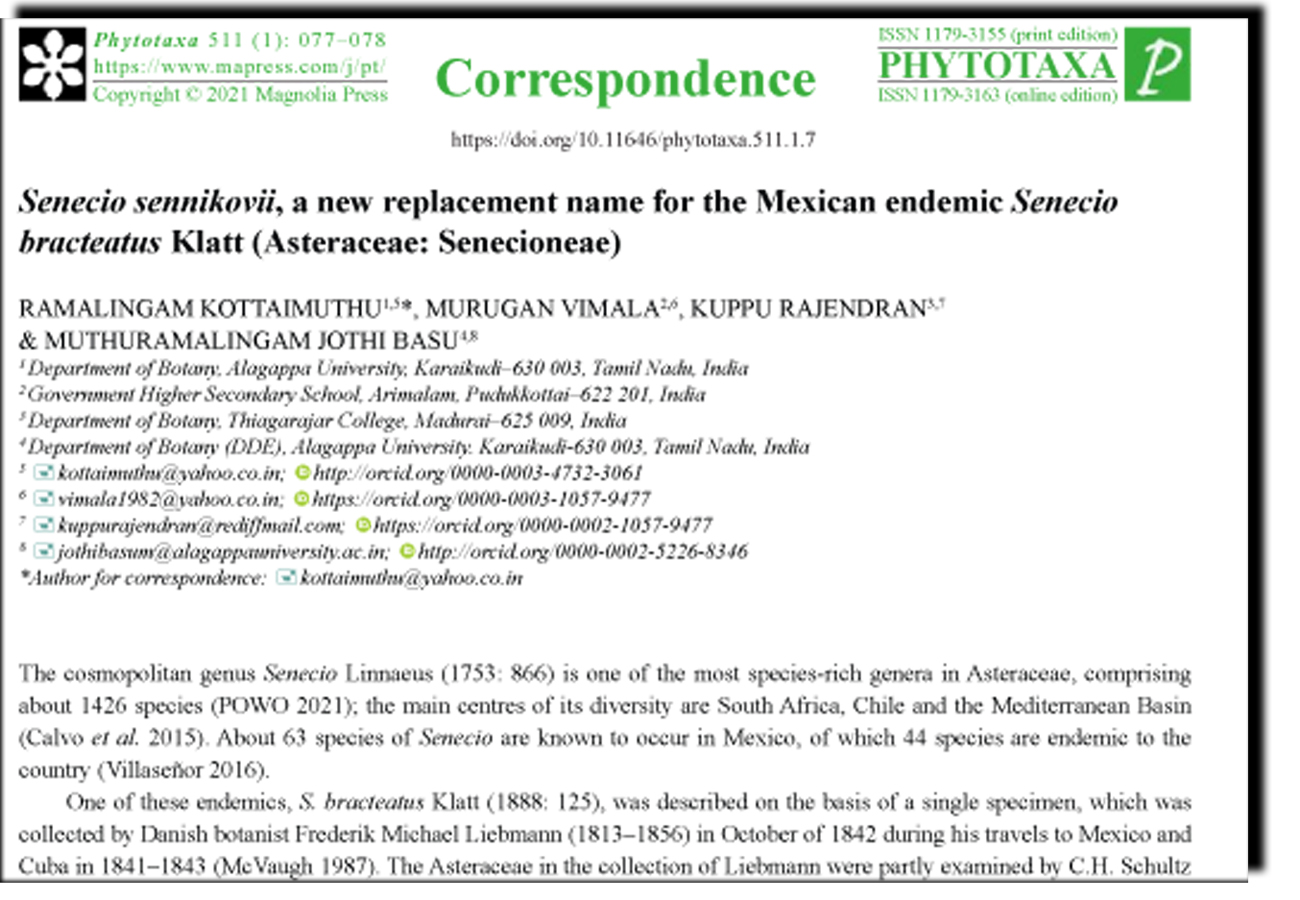Abstract
The cosmopolitan genus Senecio Linnaeus (1753: 866) is one of the most species-rich genera in Asteraceae, comprising about 1426 species (POWO 2021); the main centres of its diversity are South Africa, Chile and the Mediterranean Basin (Calvo et al. 2015). About 63 species of Senecio are known to occur in Mexico, of which 44 species are endemic to the country (Villaseñor 2016).
References
Boissier, P.E. (1856) Diagnoses Plantarum Orientalium novarum, ser. 2, vol. 3. B. Herrmann, Leipzig, 177 pp.
Calvo, J., Álvarez, I. & Aedo, C. (2015) Systematics of Senecio section Crociseris (Compositae, Senecioneae). Phytotaxa 211 (1): 1–105. https://doi.org/10.11646/phytotaxa.211.1.1
GBIF (2021) Senecio bracteatus Klatt. Available from: https://www.gbif.org/species/7789077 (accessed 4 June 2021)
Greenman, J.M. (1901) Monographie der nord- und centralamerikanischen Arten der Gattung Senecio. I. Theil. W.Engelmann, Leipzig, 37 pp.
Greenman, J.M. (1905) Descriptions of spermatophytes from the southwestern United States, Mexico, and Central America. Contributions from the Gray Herbarium of Harvard University 31: 235–270.
Klatt, F.W. (1888) Beiträge zur Kenntniss der Compositen. Leopoldina 24: 124–128.
Linnaeus, C. (1753) Species Plantarum. L. Salvius, Stockholm, 1200 pp. https://doi.org/10.5962/bhl.title.37656
McVaugh, R. (1987) Itinerary and Gazetteer. Liebmann’s Mexican Ferns: His Itinerary, a Translation of His “Mexicos Bregner,” and a Reprinting of the Original Work. Contributions from the New York Botanical Garden 19: 5–38.
POWO (2020) Senecio. Available from: http://powo.science.kew.org/taxon/urn:lsid:ipni.org:names:325904-2 (accessed 4 June 2021)
Solbrig, O.T. (1965) The Klatt Herbarium of Compositae at Harvard. Taxon 14 (6): 188–191. https://doi.org/10.2307/1217143
Turland, N.J., Wiersema, J.H., Barrie, F.R., Greuter, W., Hawksworth, D.L., Herendeen, P.S., Knapp, S., Kusber, W.-H., Li, D.-Z., Marhold, K., May, T.W., McNeill, J., Monro, A.M., Prado, J., Price, M.J. & Smith, G.F. (2018) International Code of Nomenclature for algae, fungi, and plants (Shenzhen Code) adopted by the Nineteenth International Botanical Congress Shenzhen, China, July 2017. Regnum Vegetabile 159. Koeltz Botanical Books, Glashütten. https://doi.org/10.12705/Code.2018
Villaseñor, J.L. (2016) Checklist of the native vascular plants of Mexico. Revista Mexicana de Biodiversidad 87: 559–902. https://doi.org/10.1016/j.rmb.2016.06.017
Calvo, J., Álvarez, I. & Aedo, C. (2015) Systematics of Senecio section Crociseris (Compositae, Senecioneae). Phytotaxa 211 (1): 1–105. https://doi.org/10.11646/phytotaxa.211.1.1
GBIF (2021) Senecio bracteatus Klatt. Available from: https://www.gbif.org/species/7789077 (accessed 4 June 2021)
Greenman, J.M. (1901) Monographie der nord- und centralamerikanischen Arten der Gattung Senecio. I. Theil. W.Engelmann, Leipzig, 37 pp.
Greenman, J.M. (1905) Descriptions of spermatophytes from the southwestern United States, Mexico, and Central America. Contributions from the Gray Herbarium of Harvard University 31: 235–270.
Klatt, F.W. (1888) Beiträge zur Kenntniss der Compositen. Leopoldina 24: 124–128.
Linnaeus, C. (1753) Species Plantarum. L. Salvius, Stockholm, 1200 pp. https://doi.org/10.5962/bhl.title.37656
McVaugh, R. (1987) Itinerary and Gazetteer. Liebmann’s Mexican Ferns: His Itinerary, a Translation of His “Mexicos Bregner,” and a Reprinting of the Original Work. Contributions from the New York Botanical Garden 19: 5–38.
POWO (2020) Senecio. Available from: http://powo.science.kew.org/taxon/urn:lsid:ipni.org:names:325904-2 (accessed 4 June 2021)
Solbrig, O.T. (1965) The Klatt Herbarium of Compositae at Harvard. Taxon 14 (6): 188–191. https://doi.org/10.2307/1217143
Turland, N.J., Wiersema, J.H., Barrie, F.R., Greuter, W., Hawksworth, D.L., Herendeen, P.S., Knapp, S., Kusber, W.-H., Li, D.-Z., Marhold, K., May, T.W., McNeill, J., Monro, A.M., Prado, J., Price, M.J. & Smith, G.F. (2018) International Code of Nomenclature for algae, fungi, and plants (Shenzhen Code) adopted by the Nineteenth International Botanical Congress Shenzhen, China, July 2017. Regnum Vegetabile 159. Koeltz Botanical Books, Glashütten. https://doi.org/10.12705/Code.2018
Villaseñor, J.L. (2016) Checklist of the native vascular plants of Mexico. Revista Mexicana de Biodiversidad 87: 559–902. https://doi.org/10.1016/j.rmb.2016.06.017


